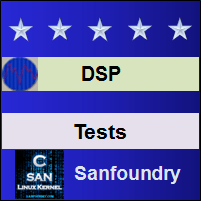 Our Digital Signal Processing Tests allow you to experience an online examination in the real-time environment. In every online test on Digital Signal Processing, you will be presented with Multiple Choice Questions (MCQs) which will test your skills in Digital Signal Processing Concepts in a detailed and comprehensive manner. In the test, each question will have 4 options to choose from. You should select only 1 correct option as an answer and then move on to the next question. Once you submit answers to all the questions, you will be given your final test score.
Our Digital Signal Processing Tests allow you to experience an online examination in the real-time environment. In every online test on Digital Signal Processing, you will be presented with Multiple Choice Questions (MCQs) which will test your skills in Digital Signal Processing Concepts in a detailed and comprehensive manner. In the test, each question will have 4 options to choose from. You should select only 1 correct option as an answer and then move on to the next question. Once you submit answers to all the questions, you will be given your final test score.In the Online Digital Signal Processing Test, for every correct answer, you will be given 2 points. There will also be negative marking of -1 for every wrong answer. So, you will have to be more careful in choosing the answers to the question in your online examination. If needed, you should skip to the next question and come back to the previous question later so that you can do proper time management for the online mock tests.
Based on your score, you would be given one of the following Grades:
Grade A* - Genius (You scored 100%)
Grade A - Excellent (Your score is in the range of 80% to 99%)
Grade B - Good (Your score is in the range of 60% to 80%)
Grade C - Average (Your score is in the range of 40% to 60%)
Grade D - Poor (Your score is in the range of 0% to 40%)
There will be 5 types of Digital Signal Processing Tests. The details of each of these tests are as follows:
 1. "Digital Signal Processing Practice Tests 1-10" - In Digital Signal Processing practice tests, there will be a series of practice tests wherein you can test your Digital Signal Processing concepts on every chapter separately. There are totally 10 different chapters on this subject and hence there will be 10 different practice tests wherein each practice tests covers one chapter exclusively. There will not be any time limit on these tests. So, Digital Signal Processing Practice Tests should be the first set of tests which you should attempt. Goto these practice tests here.
1. "Digital Signal Processing Practice Tests 1-10" - In Digital Signal Processing practice tests, there will be a series of practice tests wherein you can test your Digital Signal Processing concepts on every chapter separately. There are totally 10 different chapters on this subject and hence there will be 10 different practice tests wherein each practice tests covers one chapter exclusively. There will not be any time limit on these tests. So, Digital Signal Processing Practice Tests should be the first set of tests which you should attempt. Goto these practice tests here. 2. "Digital Signal Processing Mock Tests 1-10" - In Digital Signal Processing mock tests, there will be a series of mock tests wherein you can test your Digital Signal Processing concepts on every chapter separately, but there will be a fixed time limit per mock test. Here also, there are 10 mock tests wherein each mock test covers only one chapter exclusively. So, it is similar to Digital Signal Processing Practice Tests, but with an added constraint of time limits. You should try Digital Signal Processing Mock Tests if you are appearing for any online examination soon. Goto these mock tests here.
2. "Digital Signal Processing Mock Tests 1-10" - In Digital Signal Processing mock tests, there will be a series of mock tests wherein you can test your Digital Signal Processing concepts on every chapter separately, but there will be a fixed time limit per mock test. Here also, there are 10 mock tests wherein each mock test covers only one chapter exclusively. So, it is similar to Digital Signal Processing Practice Tests, but with an added constraint of time limits. You should try Digital Signal Processing Mock Tests if you are appearing for any online examination soon. Goto these mock tests here. 3. "Digital Signal Processing Certification Test" - Once you are thorough with your Digital Signal Processing concepts, then you can try our Digital Signal Processing Certification Test wherein your name will be mentioned in Top Rankers list, if you scored either Grade A* or Grade A in the Digital Signal Processing Certification Test. The Certification Test is free. Goto Digital Signal Processing Certification test here.
3. "Digital Signal Processing Certification Test" - Once you are thorough with your Digital Signal Processing concepts, then you can try our Digital Signal Processing Certification Test wherein your name will be mentioned in Top Rankers list, if you scored either Grade A* or Grade A in the Digital Signal Processing Certification Test. The Certification Test is free. Goto Digital Signal Processing Certification test here. 4. "Digital Signal Processing Internship Test" - If you are interested to do Internships in Digital Signal Processing at Sanfoundry, then you must take our Digital Signal Processing Internship Test. If you scored either Grade A* or Grade A in Digital Signal Processing Internship Test, then you are eligible for Internship at Sanfoundry in Digital Signal Processing. Goto Digital Signal Processing Internship test here.
4. "Digital Signal Processing Internship Test" - If you are interested to do Internships in Digital Signal Processing at Sanfoundry, then you must take our Digital Signal Processing Internship Test. If you scored either Grade A* or Grade A in Digital Signal Processing Internship Test, then you are eligible for Internship at Sanfoundry in Digital Signal Processing. Goto Digital Signal Processing Internship test here. 5. "Digital Signal Processing Job Test" - If you are a fresher, a dropout, an experienced person and if you know Digital Signal Processing well and looking out for jobs in Digital Signal Processing domain at Sanfoundry (or our Network of Companies), then you should try and qualify our "Digital Signal Processing Job Test". If you scored either Grade A* or Grade A in Digital Signal Processing Job Test, then you are eligible for a Job at Sanfoundry (or our Network) in Digital Signal Processing domain. Kindly note that you can repeat this job test after a gap of 30 days from the day of last attempt of the test. Goto Digital Signal Processing Job test here.
5. "Digital Signal Processing Job Test" - If you are a fresher, a dropout, an experienced person and if you know Digital Signal Processing well and looking out for jobs in Digital Signal Processing domain at Sanfoundry (or our Network of Companies), then you should try and qualify our "Digital Signal Processing Job Test". If you scored either Grade A* or Grade A in Digital Signal Processing Job Test, then you are eligible for a Job at Sanfoundry (or our Network) in Digital Signal Processing domain. Kindly note that you can repeat this job test after a gap of 30 days from the day of last attempt of the test. Goto Digital Signal Processing Job test here.For every "Digital Signal Processing Practice Test", Total Questions: 20, Total Time: Unlimited.
For every "Digital Signal Processing Mock Test", Total Questions: 20, Total Time: 20 Minutes.
For "Digital Signal Processing Certification Test", Total Questions: 50, Total Time: 1 hour.
For "Digital Signal Processing Internship Test", Total Questions: 50, Total Time: 1 hour.
For "Digital Signal Processing Job Test", Total Questions: 50, Total Time: 1 hour.
Before you get started on these series of online tests on Digital Signal Processing, you should learn, study and practice our collection of 1000 MCQs (Multiple Choice Questions and Answers) on Digital Signal Processing here. We also prefer that you should practice Digital Signal Processing practice tests and mock tests completely before attempting the certification test.
Here is the list of online practice tests and mock tests on Digital Signal Processing. Each online test focuses on a "Specific chapter of Digital Signal Processing". So, you should try both practice test and mock test on every chapter to do a self-assessment of your knowledge (along with time-limit constraints) in every area or sub-topic of Digital Signal Processing. Digital Signal Processing Certification test, Internship test, and Job Test are mentioned at the end of this list.
1. Digital Signal Processing Test 1 – This set of online test on “Digital Signal Processing” tests your skills on Implementation of Discrete Time Systems, Discrete Time Systems Described by Difference Equations, Analysis of Discrete time LTI Systems, Discrete Time Signals, Discrete Time Systems, Correlation of Discrete Time Signals, A2D and D2A Converters, Classification of Signals, Signals, Systems and Signal Processing.
2. Digital Signal Processing Test 2 – This set of online test on “Digital Signal Processing” tests your skills on Z Transform, Properties of Z Transform – 1, Properties of Z Transform – 2, Rational Z Transform, Inversion of Z Transform, One Sided Z Transform, Analysis of LTI System in Z Domain, Frequency Analysis of Continuous Time Signal.
3. Digital Signal Processing Test 3 – This set of online test on “Digital Signal Processing” tests your skills on Frequency Analysis of Discrete Time Signal – 1, Frequency Analysis of Discrete Time Signal – 2, Properties of Fourier Transform for Discrete Time Signals, Frequency Domain Characteristics of LTI System, LTI System as Frequency Selective Filters, Inverse Systems and Deconvolution, Frequency Domain Sampling DFT.
4. Digital Signal Processing Test 4 – This set of online test on “Digital Signal Processing” tests your skills on Properties of DFT, Linear Filtering Methods Based on DFT, Frequency Analysis of Signals Using DFT, Efficient Computation of DFT FFT Algorithms – 1, Efficient Computation of DFT FFT Algorithms – 2, Applications of FFT Algorithms, Linear Filtering Approach to Computation of DFT, Quantization Effects in the Computation of DFT, Structures for Realization of Discrete Time Systems.
5. Digital Signal Processing Test 5 – This set of online test on “Digital Signal Processing” tests your skills on Structures for FIR Systems – 1, Structures for FIR Systems – 2, Structures for IIR Systems, State-Space System Analysis and Structures, Representation of Numbers – 1, Representation of Numbers – 2, Discrete-Time Processing of Continuous Time Signals, Analysis of Quantization Errors, IIR Filter Design by the Bilinear Transformation.
6. Digital Signal Processing Test 6 – This set of online test on “Digital Signal Processing” tests your skills on Design of Low Pass Butterworth Filters – 1, Design of Low Pass Butterworth Filters – 2, Chebyshev Filters – 1, Chebyshev Filters – 2, Backward Difference Method, Bilinear Transformations, Quantization of Filter Coefficients, Round Off Effects in Digital Filters, General Considerations for Design of Digital Filters.
7. Digital Signal Processing Test 7 – This set of online test on “Digital Signal Processing” tests your skills on Design of FIR Filters, Design of Linear Phase FIR Filters Using Windows – 1, Design of Linear Phase FIR Filters Using Windows – 2, Design of Linear Phase FIR Filters by Frequency Sampling Method, Design of Optimum Equi Ripple Linear Phase FIR Filters – 1, Design of Optimum Equi Ripple Linear Phase FIR Filters – 2, Design of FIR Differentiators, Design of Hilbert Transformers, Comparison of Design Methods for Linear Phase FIR Filters.
8. Digital Signal Processing Test 8 – This set of online test on “Digital Signal Processing” tests your skills on Design of IIR Filters from Analog Filters, IIR Filter Design by Approximation of Derivatives, IIR Filter Design by Impulse Invariance, Matched Z Transformation, Characteristics of Commonly Used Analog Filters, Frequency Transformations in the Analog Domain, Frequency Transformations in the Digital Domain, Pade Approximation Method.
9. Digital Signal Processing Test 9 – This set of online test on “Digital Signal Processing” tests your skills on Least Squares Design Methods, FIR Least Squares Inverse Filters, Design of IIR Filters in Frequency Domain, Specifications and Classification of Analog Filters, Butterworth Filters, Frequency Transformations, Interpolation by a Factor I, Sampling Rate Conversion by a Rational Factor I/D.
10. Digital Signal Processing Test 10 – This set of online test on “Digital Signal Processing” tests your skills on Multirate Digital Signal Processing, Decimation by a Factor D, Oversampling A/D Converters, Sample and Hold, Sampling of Band Pass Signals, The Representation of Bandpass Signals, Quantization and Coding, Digital to Analog Conversion Sample and Hold.
Sanfoundry will issue a Certificate of Merit to Top 5 Rankers for a given month provided that they have scored either A* or A Grade in the Contest. If you are interested, then kindly register below. After registration, you can take the test anytime (24x7).
